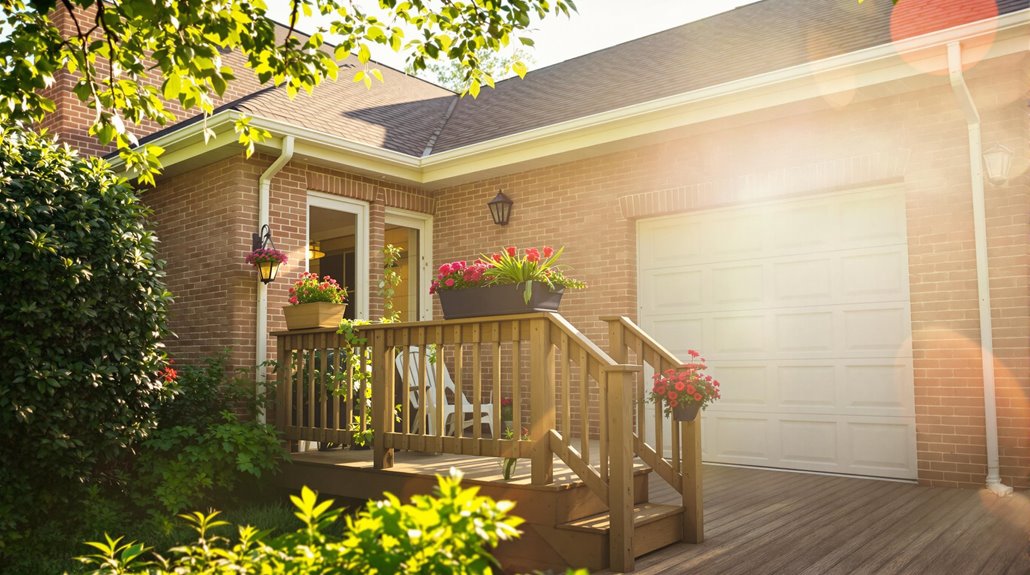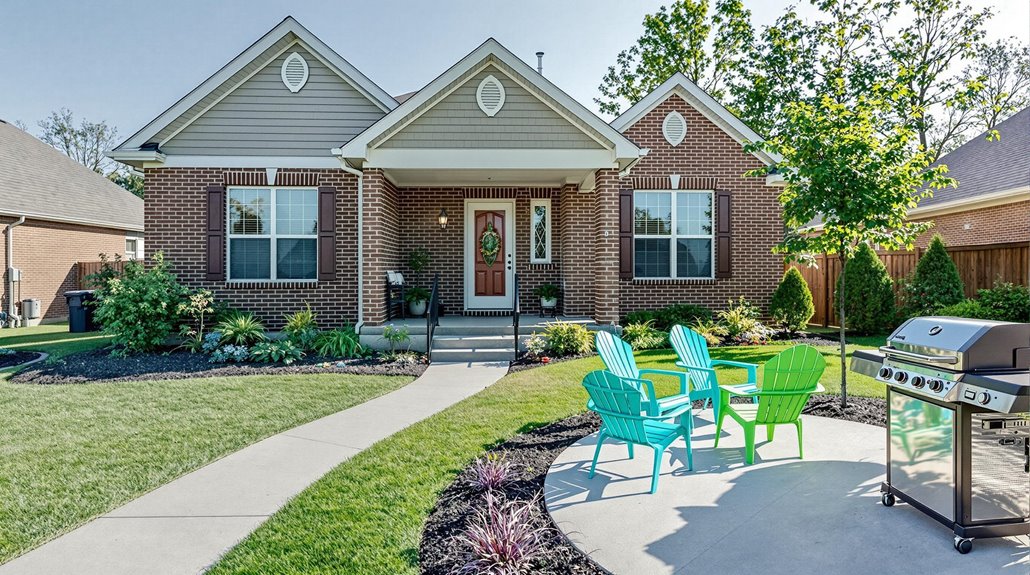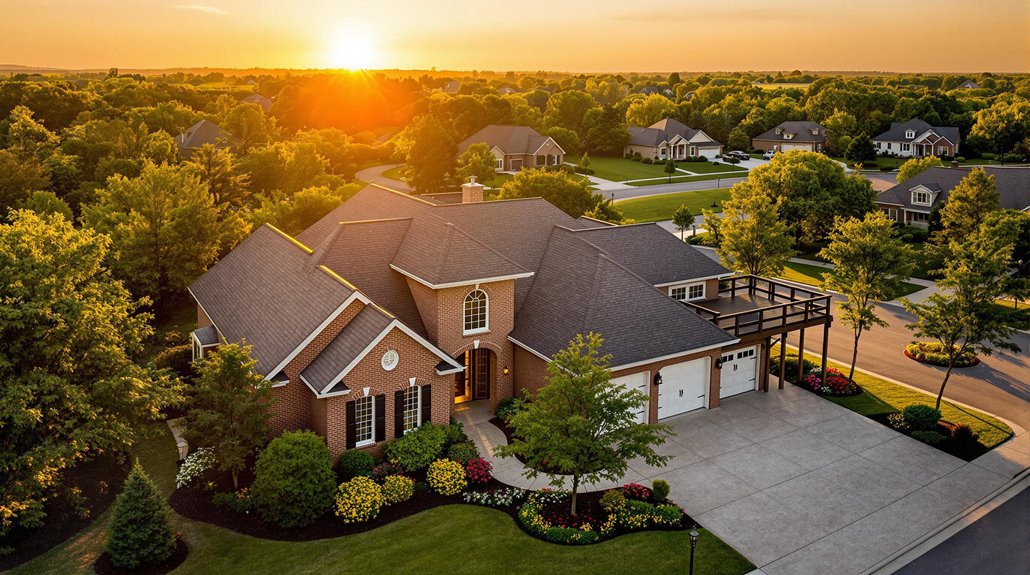Ever wondered what "real property" means when you're diving into your homeowners insurance policy? Let's break it down in plain English!
Think of real property as your home's permanent skeleton – it's everything that would stay put if you turned your house upside down. We're talking about the actual structure of your house, those attached features like built-in cabinets, and yes, even that fancy HVAC system you just installed.
What's interesting (and often overlooked) is that while your home's physical structure gets the spotlight, the land underneath isn't part of the deal. However, don't worry about your prized garden just yet – most policies throw in some coverage for landscaping and outdoor features, typically around 5% of your dwelling coverage.
Picture it this way: if you can't pack it in a moving truck, it's probably real property. This distinction becomes super important when you're figuring out your coverage needs. After all, you wouldn't want to discover gaps in your protection after that big oak tree decides to renovate your roof uninvited!
Ready to become a real property pro? Understanding these basics helps you make smarter decisions about protecting your biggest investment. Remember, what counts as real property can vary between policies, so it's worth having a chat with your insurance agent about your specific situation.
Key Takeaways
- Real property in homeowners insurance refers to the physical structure of the home and attached structures, excluding the land itself.
- Coverage typically protects against specific perils like fire and theft, with limited coverage for landscaping and gardens.
- Dwelling coverage protects the main structure and attached structures, such as garages, decks, or patios.
- Real property is distinct from personal property, which includes movable items like furniture and electronics, and has different coverage conditions.
- Understanding the distinction between real and personal property is crucial for adequate coverage and effective policy management.
Understanding Real Property in Homeowners Insurance
In the domain of homeowners insurance, a fundamental concept to grasp is the definition and scope of real property. Real property primarily refers to the physical structure of the home and any other attached structures, excluding the land itself.
Homeowners insurance policies typically cover real property against specific perils such as fire, windstorms, and theft, as outlined in the policy. Landscaping and gardens are also considered part of real property, but usually have limited coverage, often capped at 5% of the total dwelling coverage amount.
Understanding the distinction between real property and personal property is vital, as personal property includes movable items such as furniture and appliances, which may be insured differently.
Homeowners insurance provides coverage for real property-related risks, but additional endorsements may be necessary for extensive protection against specific issues. Recognizing the scope of real property in homeowners insurance is essential for adequate coverage and risk management.
For maximum protection of real property, public adjusters help secure settlements up to 700% higher than initial insurance company offers.
Key Components of Real Property Coverage

Real property coverage is a fundamental aspect of homeowners insurance, encompassing the physical structure of the home and its associated components. This type of coverage is a vital part of insurance policies, providing financial protection against various risks and perils.
The key components of real property coverage include:
- Dwelling coverage: Covers the main structure of the house and any attached structures, excluding the land itself.
- Attached structures coverage: May include coverage for attached structures such as garages, decks, or patios.
- Limited landscaping and gardens coverage: May be included, typically capped at around 5% of the dwelling's Coverage A limit.
- Option for additional endorsements: May be required for extensive coverage of specific real property risks, such as damage from slab leaks or other perils not covered in standard policies.
Homeowners should carefully review their insurance policies to understand the scope of their real property coverage. While public adjusters can assist with complex claims, they work exclusively for policyholders to ensure fair settlements.
Real Property vs. Personal Property in Insurance Policies

Homeowners insurance policies differentiate between two primary categories of coverage: real property and personal property. Real property refers to immovable items such as the land, the dwelling, and structures permanently attached to it, including fixtures like built-in appliances and central heating systems. Personal property refers to movable items within the home, such as furniture, electronics, clothing, and valuables. In homeowners insurance, personal property in homeowners insurance typically covers theft, damage, or loss of these items, whether they occur within the home or while traveling. It is essential for homeowners to assess the value of their personal belongings to ensure sufficient coverage that adequately protects their assets.
Personal property, on the other hand, includes movable items like furniture and electronics. Coverage for real property typically protects against perils such as fire and wind, whereas personal property may have different limits and coverage conditions defined in the policy.
Homeowners insurance generally covers the dwelling (real property) under Coverage A, while personal property is usually covered under Coverage C, which may have specific limits for certain types of items.
Understanding the distinction between real and personal property is essential for homeowners to guarantee adequate coverage for both categories, as limitations and exclusions can vary considerably between them. This distinction is important for effective policy management.
Working with public adjusters on property damage claims can increase settlement amounts by 30-50% compared to handling claims independently.
Types of Real Property and Their Insurance Implications

Dwellings and associated structures form the core of real property under homeowners insurance policies. This category encompasses the physical dwelling, attached structures, and permanent installations. Coverage for real property is distinct from personal property, and understanding this distinction is essential for adequate insurance protection.
Specific considerations apply to different types of real property, including:
- Physical dwelling: Coverage includes the main structure, foundation, and permanent components like plumbing and electrical systems.
- Attached structures: This includes garages, decks, and fences that are directly attached to the main dwelling.
- Permanent installations: Features like built-in appliances, cabinets, and flooring are considered part of the real property.
- Landscaping and gardens: Coverage for these is limited, only applying to specific named perils like fire or windstorms, and often capped at a percentage of the dwelling's coverage amount.
Adequate home insurance coverage for real property requires understanding these types and their implications. Standard policies typically exclude natural disaster coverage unless specific endorsements or separate policies are obtained.
Navigating Real Property Claims and Coverage Options

While the specific details of a policy can greatly impact the available coverage, understanding how to navigate the claims process for real property is essential for homeowners to receive adequate compensation in the event of damage or loss.
Homeowners must meticulously document damage and be aware of their policy's specific coverage details for real property, which can affect the claim's approval and compensation. Insurance cover for real property typically includes the dwelling and other structures, but excludes the land itself.
Homeowners should also consider additional coverage options, such as debris removal and service line coverage, to protect against unforeseen expenses related to real property damages. Understanding these nuances can considerably impact the outcome of a claim.
Moreover, recognizing policy limitations, like those related to landscaping and garden coverage, allows homeowners to make informed decisions about their insurance cover and potential needs for supplemental protection.
Maintaining transparent communication with insurance providers throughout the claims process is crucial for achieving optimal results and expediting claim resolution.
The Benefits Of Consulting A Public Adjuster

In the context of real property claims, consulting a public adjuster can provide policyholders with expertise in insurance claims, ensuring a thorough understanding of policy terms and conditions.
A public adjuster's objective damage assessment capabilities can also help to establish a clear and accurate claim value, reducing the risk of disputes with the insurance company.
Expertise In Insurance Claims
Engaging a public adjuster can be a strategic move for homeowners steering the complex process of insurance claims, especially when it comes to real property damages. Their expertise in managing insurance policies can greatly improve the chances of receiving a fair settlement.
Some key benefits of consulting a public adjuster include:
- Increased settlement amounts: Studies have shown that policyholders who hire public adjusters often receive settlements that are 20% to 30% higher than those who navigate the claims process independently.
- Specialized knowledge: Public adjusters possess in-depth knowledge of insurance policies, enabling them to identify covered damages that homeowners may overlook.
- Time-saving: Public adjusters handle the entire claims process, alleviating stress and saving time for homeowners.
- Contingency fee basis: Public adjusters only get paid if the claim is successful, incentivizing them to maximize the claim amount.
Objective Damage Assessment
Evaluating property damage objectively is essential in guaranteeing that insurance claims accurately reflect the extent of losses incurred. Consulting a public adjuster can provide an unbiased assessment of real property damage, resulting in fairer representation in insurance claims.
As licensed professionals working on behalf of policyholders, public adjusters help navigate policy language related to real property coverage. Their expertise in evaluating damage to structures, landscaping, and other permanent fixtures leads to a thorough understanding of what insurance will cover.
Statistics show policyholders who use public adjusters often receive 20-50% higher settlements. Involving a public adjuster guarantees all necessary documentation is prepared and submitted correctly, expediting the claims process and maximizing the claim amount.
This professional assistance is invaluable in securing fair compensation.
Streamlined Claim Process
Utilizing the expertise of a public adjuster can greatly expedite the claims process for homeowners traversing complex insurance policies. This is particularly beneficial when dealing with real property insurance claims, which can be intricate and time-consuming.
The benefits of consulting a public adjuster include:
- Expert Policy Interpretation: Public adjusters possess in-depth knowledge of insurance policies, guaranteeing accurate interpretation and application.
- Accurate Damage Documentation: Public adjusters guarantee that all covered damages are thoroughly documented and reported.
- Efficient Claim Submission: With a thorough understanding of the claims process, public adjusters can expedite the submission of necessary documentation.
- Stress-Free Negotiations: Public adjusters handle negotiations with the insurer, relieving homeowners of stress and complexity. By leveraging their expertise, homeowners can navigate the claims process more efficiently.
Higher Claim Payouts & Settlements
A key advantage of hiring a public adjuster lies in their ability to secure higher claim payouts and settlements. This is particularly beneficial for homeowners seeking to maximize the value of their real property claims.
By leveraging their expertise in evaluating property damage and negotiating with insurance companies, public adjusters can secure settlements that are, on average, 20% to 50% higher than those obtained by homeowners handling claims independently.
Their in-depth knowledge of homeowners insurance policies enables them to identify all covered losses, compile necessary evidence, and navigate the claims process efficiently.
As a result, homeowners can receive higher payouts for damages to their home, thereby minimizing financial losses and expediting the recovery process.
About The Public Claims Adjusters Network (PCAN)

The Public Claims Adjusters Network (PCAN) comprises a national network of expert public adjusters, pre-vetted and verified to specialize in residential and commercial property damage insurance claims.
PCAN serves as a resource for policyholders to connect with expert public adjusters who are licensed and experts in their field. Public adjusters in the PCAN are considered to be the best-of-the-best and must go through an intensive application and interview process to be admitted.
Key characteristics of PCAN member adjusters include:
- State-licensed and verified expertise: All member adjusters are licensed and have demonstrated expertise in handling residential and commercial property damage insurance claims.
- Pre-vetted for excellence: Member adjusters must undergo a rigorous application and interview process to guarantee they meet the highest standards.
- Yearly audits for compliance: Member adjusters are subject to mandatory yearly audits to guarantee their licenses are up-to-date and they have no outstanding complaints.
- Specialization in real property claims: PCAN member adjusters cover over 30 different claim types related to real property.
Frequently Asked Questions
What Is Considered Real Property in Insurance?
In insurance, real property encompasses physical land and structures permanently attached, including dwellings, garages, and sheds. This property classification covers fixtures like sinks and flooring, and is distinct from personal property, resembling real estate ownership principles.
What Does the Real Property Generally Include?
For a homeowner, real property generally includes the physical structure of their dwelling, land improvements such as a patio, and other permanent fixtures within property boundaries, excluding the land itself, which serves as the foundation.
Which of the Following Would Not Be Classified as Real Property?
Temporary or non-permanent items, such as outdoor furniture, tents, or inflatable pools, are classified as personal property and fall outside real property classifications due to their ability to be moved or relocated with ease.
What Is the Difference Between Tangible and Real Property?
Like a Civil War-era homesteader's movable wagon versus their claim to acres of land, tangible assets are physical and portable, while real property is fixed and defined by property classification that secures rights and ownership.








